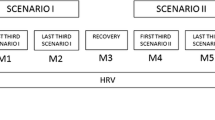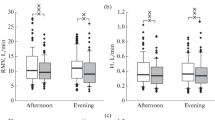Abstract
The effects of anxiety on the external respiration system and respiratory sinus arrhythmia (RSA) were studied in healthy subjects in real-life conditions. Changes in external respiration parameters and heart rate variability (HRV) in students going to take their end-of-term exams were assessed relative to a midterm period, and the cardiorespiratory system was monitored in a longitudinal study for 50 days. The function of the cardiorespiratory system was characterized by measuring external respiration parameters and calculating HRV parameters. State anxiety (SA) was assessed using Spielberger’s scale. An increase in SA before an exam was accompanied by a higher breathing rate, a higher tidal volume, and lower HRV indices, especially those related to respiratory sinus arrhythmia (HF and HF norm). The changes in the parameters depended on the increase in SA. A negative correlation was observed between midterm HF and pre-exam SA. The longitudinal study revealed a distinct negative correlation between respiratory sinus arrhythmia parameters and peak expiratory flow (PEF) and a positive correlation between SA and PEF in the majority of subjects. Changes in cardiorespiratory parameters depended on the changes in SA in the longitudinal study. An increase in SA was accompanied by substantial changes in respiratory sinus arrhythmia (RAS) and external respiration parameters, and their correlation was assumed to indicate that modification of parasympathetic activity plays a leading role in increasing PEF.
Similar content being viewed by others
References
Kreibig, S.D., Autonomic nervous system activity in emotion: A review, Biol. Psychol., 2010, vol. 84, no. 3, p. 394.
Dedovic, K., The brain and the stress axis: The neural correlates of cortisol regulation in response to stress, Neuroimage, 2009, vol. 47, no. 3, p. 864.
Homma, I. and Masaoka, Y., Breathing rhythms and emotions, Exp. Physiol., 2008, vol. 93, no. 9, p. 1011.
Grishin, O.V., Grishin, V.G., and Uryumtsev, D.Yu., Capnographic parameters of the breathing pattern in norm and psychogenic dyspnea, Fiziol. Chel., 2012, vol. 38, no. 4, p. 59.
Van Diest, I., Winters, W., Devriese, S., et al., Hyperventilation beyond fight/flight: Respiratory responses during emotional imagery, Psychophysiology, 2001, vol. 38, no. 6, p. 961.
Blechert, J., Lajtman, M., Michael, T., et al., Identifying anxiety states using broad sampling and advanced processing of peripheral physiological information, Biomed. Sci. Instrum., 2006, vol. 42, p. 136.
Kreibig, S.D., Autonomic nervous system activity in emotion: A review, Biol. Psychol., 2010, vol. 84, no. 3, p. 394.
Homma, I., Breathing and Noh: Emotional Breathing. New Frontiers in Respiratory Control, New York: Springer, 2010, p. 337.
Balteş, F.R., Avram, J., Miclea, M., and Miu, A.C., Emotions induced by operatic music: Psychophysiological effects of music, plot, and acting: A scientist’s tribute to Maria Callas, Brain Cogn., 2011, vol. 76, no. 1, p. 146.
The Handbook of Stress Science, Contrada, R.J. and Baum, A., Eds., New York: Springer, 2011.
Abelson, J.L., Khan, S., and Giardino, N., HPA axis, respiration and the airways in stress-a review in search of intersections, Biol. Psychol., 2010, vol. 84, no. 1, p. 57.
Pattyn, N., Migeotte, P.F., Neyt, X., et al., Comparing real-life and laboratory-induced stress reactivity on cardio-respiratory parameters: Differentiation of a tonic and a phasic component, Physiol. Behav., 2010, vol. 101, no. 2, p. 218.
Ritz, T., Kullowatz, A., Goldman, M.D., et al., Airway response to emotional stimuli in asthma: The role of the cholinergic pathway, J. Appl. Physiol., 2010, vol. 108, no. 6, p. 1542.
Von Leupoldt, A., Ehnes, F., and Dahme, B., Emotions and respiratory function in asthma: A comparison of findings in everyday life and laboratory, Br. J. Health Psychol., 2006, vol. 11, no. 2, p. 185.
Ben-Tal, A., Shamailov, S.S., and Paton, J.F., Evaluating the physiological significance of respiratory sinus arrhythmia: Looking beyond ventilation-perfusion efficiency, J. Physiol., 2012, vol. 590, no. 8, p. 1989.
Grossman, P. and Taylor, E.W., Toward understanding respiratory sinus arrhythmia: Relations to cardiac vagal tone, evolution and biobehavioral functions, Biol. Psychol., 2007, vol. 74, no. 2, p. 263.
Licht, C.M., de Geus, E.J., Van Dyck, R., and Penninx, B.W., Association between anxiety disorders and heart rate variability in the Netherlands study of depression and anxiety (NESDA), Psychosom. Med., 2009, vol. 71, no. 5, p. 508.
Jönsson, P., Respiratory sinus arrhythmia as a function of state anxiety in healthy individuals, Int. J. Psychophysiol., 2007, vol. 63, no. 1, p. 48.
Ritz, T., Alatupa, S., Thns, M., and Dahme, B., Effects of affective picture viewing and imagery on respiratory resistance in nonasthmatic individuals, Psychophysiology, 2002, vol. 39, no. 1, p. 86.
Khanin, Yu.L., Kratkoe rukovodstvo k primeneniyu shkaly reaktivnoi i lichnostnoi trevozhnosti Ch.D. Spilbergera (Brief Guidance on the Use of Spielberger’s State and Personal Anxiety Scale), Leningrad: LNIIFK, 1976.
Miller, M.R., Hankinson, J., and Brusasco, V., Standardisation of spirometry, Eur. Respir. J., 2005, vol. 26, p. 319.
Camm, A.J., Malik, M., Bigger, J.T., et al., Task force of the European Society of Cardiology and the North American Society of Pacing and Electrophysiology: Heart rate variability: Standards of measurement, physiological interpretation, and clinical use, Circulation, 1996, vol. 93, p. 1043.
Sato, N. and Miyake, S., Cardiovascular reactivity to mental stress: Relationship with menstrual cycle and gender, J. Physiol. Anthropol. Appl. Human Sci., 2004, vol. 23, no. 6, p. 215.
Diggle, P., Heagerty, P., Liang, K.Y., and Zeger, S., Analysis of longitudinal data, Oxford University Press, 2013, no. 25.
Friedman, B.H., An autonomic flexibility-neurovisceral integration model of anxiety and cardiac vagal tone, Biol. Psychol., 2007, vol. 74, no. 2, p. 185.
Kemp, A.H., Quintana, D.S., Felmingham, K.L., et al., Depression, comorbid anxiety disorders, and heart rate variability in physically healthy, unmedicated patients: Implications for cardiovascular risk, PLoS One, 2012, vol. 7, no. 2, p. 30 777.
Miu, A.C., Heilman, R.M., and Miclea, M., Reduced heart rate variability and vagal tone in anxiety: Trait versus state, and the effects of autogenic training, Auton. Neurosci., 2009, vol. 145, nos. 1–2, p. 99.
Sakuragi, S., Sugiyama, Y., and Takeuchi, K., Effects of laughing and weeping on mood and heart rate variability, J. Physiol. Anthropol. Appl. Hum. Sci., 2002, vol. 21, no. 3, p. 159.
Bleil, M.E., Gianaros, P.J., Jennings, J.R., et al., Trait negative affect: Toward an integrated model of understanding psychological risk for impairment in cardiac autonomic function, Psychosom. Med., 2008, vol. 70, no. 3, p. 328.
Porges, S.W., The polyvagal perspective, Biol. Psychol., 2007, vol. 74, no. 2, p. 116.
Kogan, A.V., Allen, J.J., and Weihs, K.L., Cardiac vagal control as a prospective predictor of anxiety in women diagnosed with breast cancer, Biol. Psychol., 2012, vol. 90, no. 1, p. 105.
Ritz, T., Claussen, C., and Dahme, B., Experimentally induced emotions, facial muscle activity, and respiratory resistance in asthmatic and non-asthmatic individuals, Brit. J. Med. Psychol., 2001, vol. 74, no. 2, p. 167.
Campbell, T.S., Lavoie, K.L., Bacon, S.L., et al., Asthma self-efficacy, high frequency heart rate variability, and airflow obstruction during negative affect in daily life, Int. J. Psychophysiol., 2006, vol. 62, no. 1, p. 109.
Herbert, R.W.L. and Bolten, C., Respiratory sinus arrhythmia and the heart rate response to carotid baroreceptor activation after hard dynamic exercise in humans, Autonomic Neurosci. Basic, 2002, vol. 100, no. 1, p. 84.
Ritz, T., Wilhelm, F.H., Meuret, A.E., et al., Airway response to emotion- and disease-specific films in asthma, blood phobia, and health, Psychophysiology, 2011, vol. 48, no. 1, p. 121.
Ritz, T., Rosenfield, D., Dewilde, S., and Steptoe, A., Daily mood, shortness of breath, and lung function in asthma: Concurrent and prospective associations, J. Psychosom. Res., 2010, vol. 69, no. 4, p. 341.
Canning, B.J. and Fischer, A., Neural regulation of airway smooth muscle tone, Respir. Physiol., 2001, vol. 125, p. 113.
Author information
Authors and Affiliations
Corresponding author
Additional information
Original Russian Text © D.A. Dimitriev, E.V. Saperova, A.D. Dimitriev, Yu.D. Karpenko, 2014, published in Fiziologiya Cheloveka, 2014, Vol. 40, No. 4, pp. 91–98.
Rights and permissions
About this article
Cite this article
Dimitriev, D.A., Saperova, E.V., Dimitriev, A.D. et al. Effect of anxiety on the function of the cardiorespiratory system. Hum Physiol 40, 433–439 (2014). https://doi.org/10.1134/S0362119714040069
Received:
Published:
Issue Date:
DOI: https://doi.org/10.1134/S0362119714040069




